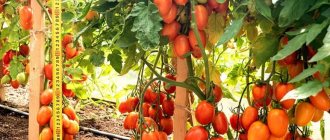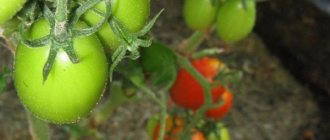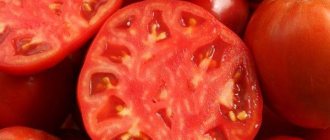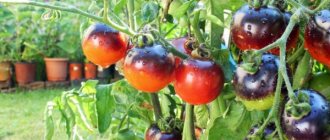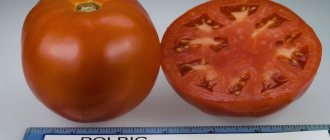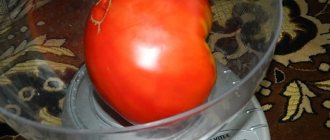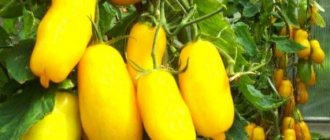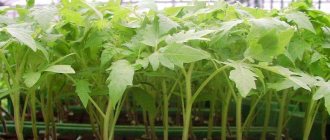» Vegetable growing » Tomatoes » Varietal characteristics of tomato Chernomor
0
1280
Article rating
This tomato stands out among others. The Chernomor tomato is a striking example of a variety that is distinguished not only by the unusual appearance of the fruit, but also by numerous other advantages.
- Advantages and disadvantages
- Growing
- Landing
- Care
- Transfer
- Care instructions
- Disease and pest control
- Harvest and storage
- Reviews from gardeners
Varietal characteristics of tomato Chernomor
Brief information about the variety
- Fruits : average weight 200-300 g, dark burgundy color with a purple tint; The bush is semi-determinate, the height is on average 1-1.5 m.
- Productivity : high - from one bush under favorable conditions you get 5-7 kg of full-fledged fruits.
- Resistance to diseases and pests : the variety is moderately resistant, susceptible to late blight, sulfur and root rot. Among the pests, it is attacked by aphids and the Colorado potato beetle.
- Distribution : the crop is grown in central Russia. For greenhouse cultivation - in the northern regions.
- Application : the fruits are universal - they are used fresh for preparing salads and for home canning.
- Planting : the seedling method is used, the timing of sowing seeds is the beginning of spring, the scheme is 40x60.
- Soil : fertile, nutritious, light. In terms of composition, it has low acidity levels.
- Care : requires pinching and gartering. The bush is formed into 2-3 stems. Watering is moderate and regular. Complex, organic, as well as potassium and phosphorus fertilizers are used as fertilizing.
- Ripening period : end of July-August. Suitable for short-term storage and transportation.
Productivity
“Chernomor” attracts gardeners also because the variety shows fairly high yields.
Experience shows that even summer residents who are inexperienced in matters of agricultural technology can get 3-4 kilograms of juicy tomatoes from one bush per season, although ideally you can collect 6-7 kilograms of tomatoes from one bush. Important! You can increase the yield of tomatoes of this variety by using mineral and organic fertilizers. Proper feeding of the bushes will also help.
Characteristics of the variety
When purchasing a new variety of vegetables, you must first read its description. This makes it possible to take into account all the features of growing tomatoes and allows you to find out the crop yield indicators in advance.
This variety of tomato is classified as mid-season; the first harvest is harvested from the bushes 110-125 days after emergence. The crop is grown both in open ground and in greenhouse conditions. In the second case, the fruits ripen 1.5-2 weeks earlier than stated.
Description of the bush and fruits
A tomato bush of this variety has the following characteristics:
- the plant is semi-determinate, its height is 1.5 m;
- large, branched stems require regular pinching and tying to supports;
- the maximum yield is obtained when a bush is formed with 2-3 stems;
- foliage is medium, leaf color is rich green.
The fruits are round, slightly flattened. The peculiarity of tomatoes is their unusual color. In a state of biological ripeness, the fruits become purple-burgundy. The weight of one copy is 200-300 g.
The tomato pulp is dense but juicy, the taste is sweet with a characteristic sourness. The fruits are good for their versatility of use: they are used fresh, for winter preservation in the form of sauces, pastes, and lecho.
Due to the large amount of antioxidants in fruits, they are widely used in dietary and baby food.
Tomatoes are not prone to cracking, store well, and withstand long-term transportation well.
Productivity
Under favorable conditions for the plant, the crop yield is high: 5-7 kg of full-fledged fruits can be collected from one bush per season. To increase these indicators, it is important to feed tomatoes with organic and mineral fertilizers on time.
Disease resistance
The Chernomor variety is classified as moderately resistant to diseases typical of tomatoes. To protect the plant, it is necessary to carry out timely preventive treatments using special fungicides or folk remedies.
When growing tomatoes in a greenhouse, it is important to systematically ventilate it. Mulching the soil will help prevent pests.
Growing regions
When grown in greenhouses, the variety can be planted in almost any climatic zone. For planting in open ground, central Russia, where the climate is temperate and relatively mild, is most suitable for the plant. Cultivation of the variety in the Siberian regions did not show positive results.
Planting seedlings in the garden
Tomatoes are planted in the garden at the beginning of June. If seedlings are to be planted in a greenhouse or hotbed, this can be done 3 weeks earlier. The soil for planting tomato seedlings must first be dug up and loosened. Make small holes in it and add a tablespoon of superphosphate or wood ash to each hole. For 1 sq. m place 4 bushes of seedlings. Lightly compact the soil and pour water under the roots.
Advantages and disadvantages
Very prolific variety
The obvious advantages of Chernomor tomatoes include:
- high taste qualities of the fruits, the presence of a large amount of vitamins and antioxidants in them;
- fruits are adapted for long-term storage and transportation;
- the variety is relatively unpretentious in care, requiring only basic agrotechnical methods;
- in areas with warm climatic conditions it is successfully grown in open ground.
Among the main disadvantages are the susceptibility of tomatoes to diseases such as late blight, the need for gartering and pinching of bushes.
Watch the video for the best varieties of black tomatoes
If you grew Chernomor tomatoes, please write whether you liked them or not. What was the yield and taste of the fruits like under your climatic conditions? How do you rate the disease resistance of this variety? Briefly describe the advantages and disadvantages of this tomato in your opinion. If possible, attach a photo of the entire bush or individual fruits you grew to your comment. Thank you!
Your reviews of the Chernomor tomato and additions to the description will help many gardeners evaluate this variety more objectively and decide whether it is worth planting or not.
This is a natural variety of tomato. Therefore, we recommend taking seeds from a ripe fruit and using them for planting in subsequent seasons.
Website about tomatoes - Tomatland.
Growing
The seedling method is predominantly used for growing tomatoes. This allows you to get an earlier harvest, and by the time the seedlings are transferred to a permanent place, they will already have a well-developed root system and high immunity, which will allow them to take root in the garden as quickly as possible.
Landing
The time for sowing tomato seeds is in the first half of March. Humus and garden soil mixed in equal proportions are used as a soil mixture for seedlings. The soil should be nutritious and light, previously disinfected.
Seed material is disinfected in solutions of potassium permanganate before use. Some people, before sowing seeds, soak them in growth stimulants and further germinate them.
The prepared material is sown in common containers or separate pots. The seeds are deepened into pre-moistened soil by 1.5-2 cm. After sowing, the boxes are covered with film to maintain soil moisture until the seeds germinate and placed in a warm place.
The optimal temperature for this is 23-25 °C. After the first shoots appear, the polyethylene is removed and the container is transferred to a well-lit place.
Care
The appearance of 1-2 true leaves on the seedlings requires their subsequent picking (transplantation) into separate pots. The diameter of such containers should be 6-8 cm, and the volume should be at least 0.25 liters. The picking is carried out carefully to prevent damage to the delicate root system of the crop.
After picking, you can fertilize the young plants with liquid complex fertilizer. The next feeding is carried out before planting the crop in a permanent place.
():
The first feeding of seedlings after picking is carried out 7-10 days later, when it has taken root well and the roots begin to “work”.
The description says that watering is carried out using a spray bottle or watering can. The water used is exclusively settled and slightly heated. It is important not to allow the soil to become waterlogged: this can provoke the occurrence of fungal diseases in the soil and the infection of still immature seedlings by harmful bacteria.
():
You cannot use a spray bottle as a watering agent when growing tomato seedlings. High air humidity and the presence of droplet-liquid moisture on the leaves can lead to the development of fungal diseases. Only a watering can with a small spout!
Transfer
50-60 days after emergence, the seedlings are transferred to a permanent place. When growing in greenhouses, this procedure is carried out in early May; for open ground, the timing is later - late May or early June, when the soil is well heated and the risk of frost is minimal.
Planting pattern: distance between plants - at least 40 cm, between rows - 60 cm. Pour 1 tbsp into each hole. l. wood ash and superphosphate and pour in a sufficient amount of water. The depth of the hole should correspond to the large size of the seedling's root system. After planting, the soil is slightly compacted.
Picking seedlings
When the sprouts get stronger and the first 2 true leaves appear, pick them - planting the sprouts in separate containers. This procedure is very painful for tomatoes, but necessary, since picking increases the plant’s immunity and makes it strong.
Prepare containers with garden soil again. Carefully pry the soil from the bottom of the sprouts with a spatula and remove the sprouts along with a lump of earth. Replant to a new location, after making small depressions in the soil. Lightly compact the soil with your fingers and sprinkle with warm, settled water. Keep containers in a well-sunny place.
Care instructions
It is necessary to water the Chernomor tomato variety as the soil dries out (once every 5-7 days), avoiding the formation of a hard earthen crust. The drip irrigation method is popular, in which the risk of soil waterlogging is minimal. It is recommended to use settled, non-cold water.
After watering, it is advisable to loosen the soil and remove weeds between the bushes. This will improve air circulation in the root zone and will retain moisture in the soil for a longer time.
During the entire growing season, tomatoes need 3-4 feedings with nutrients. To do this, use complex fertilizers in liquid form, which alternate with watering with mullein solution. During the period of flowering and active formation of the ovary, it is advisable to fertilize the soil with potassium-phosphorus substances.
The Chernomor variety is tall, and therefore requires timely tying of stems and shoots to stable supports. Regularly, as it grows, the lower leaves and some of the side shoots need to be removed.
Pruning is carried out in such a way that the growth of the remaining shoots is directed vertically upward. The bush is formed into 2-3 stems. Large fruits are obtained from 5-6 peduncles located on one branch.
Description of the tomato variety Chernomorets, reviews, photos
The original name of the tomato is Black sea man .
Early ripening, semi-determinate, productive, rare variety of dark-fruited tomatoes. In the middle zone, it is recommended to grow it in a greenhouse.
The bush is 1.5-1.7 meters high in the greenhouse, lower in the greenhouse. Requires tying to the support and pinning. The best results were obtained when forming a plant with 2 or 3 stems. Regular type sheet.
Fruit characteristics
The fruits are flat-rounded and round, in the ripe stage, burgundy-brown in color with dark green shoulders, weighing 150-300 grams, good, tomato taste (with sourness). Not prone to cracking. There are olive stripes on the cut. These tomatoes are good for fresh consumption, making juices and sauces.
The fruits are approximately the same size on both the lower and upper clusters.
The variety is resistant to major tomato diseases. Due to its early ripeness, it “escapes” late blight.
Disease and pest control
The main problem of Chernomor tomatoes is late blight, which can be dealt with by regular ventilation of the greenhouse, pinching of bushes, preventive treatment of plants with copper-containing fungicides or folk remedies (solution of wood ash, potassium permanganate, copper sulfate, hydrogen peroxide, nettle infusion, etc.).
Gray and root rot can be prevented by moderate watering of vegetables and treatment with special antifungal drugs (Fitosporin).
Pest attacks will be prevented by mulching the soil around the bushes. For this, straw, sawdust, last year's leaves, etc. are used. A concentrated solution of laundry soap will help against aphids, which can be used to wash them off the plant. When flying insect pests occur, plants are sprayed with insecticides.
Growing seedlings at home
For seedlings, it is necessary to choose not only high-quality seeds, but also suitable soil. So, the best option for the Chernomor tomato is a mixture of equal amounts of humus and turf soil, to which a small amount of wood ash is added.
The main stage is seed preparation. Healthy ones have a yellow tint. The first thing to do is treat the seeds with hot water. The optimal temperature is +60 degrees. Instead, you can warm the seeds under a lamp at the same temperature. This is necessary in order to prevent seedlings from becoming infected with pathogenic microflora. Treatment with a weak - one percent - solution of potassium permanganate is suitable for disinfection. The seeds must be kept in it for 24 hours.
After the hardening procedure, the seeds can be sown in boxes or glasses. By the way, a week before planting, the soil must be warmed up at room temperature. The soil should be watered with a weak solution of potassium permanganate. When sowing seeds, keep in mind that some of the seedlings will die after transplantation, and another part will die from pests after planting in the ground. Therefore, experienced gardeners advise growing 30% more seedlings than necessary.
In order to ensure good growth of seedlings, they must be illuminated for at least 10 hours a day. This may require fluorescent lamps. If you use only natural light, the plants will stretch towards it. During the day, the temperature should not fall below +20°C, but it is better if its level is about 23-26 degrees. Night temperature should not fall below +17. As soon as the third true leaf appears on the Chernomor tomato, the seedlings can be planted.
Reviews from gardeners
Gardeners have divided opinions about tomatoes. Those who grew this variety note the high taste qualities of the fruits and their unusual appearance. But the crop is often subject to late blight, which causes a lot of inconvenience.
By following the basic rules of agricultural technology, even a novice gardener can grow Chernomor tomatoes, especially in greenhouse conditions. It is advisable to cultivate tomatoes in open ground in regions with a temperate climate, otherwise yields will be significantly lower.
According to reviews from vegetable growers, the tomatoes are aromatic and juicy. In their entire form, almost no one preserves them, but they make excellent adjika and lecho for the winter. Just a few bushes of the plant can provide a family with vegetables with remarkable taste characteristics.
Transplantation into the ground
It is necessary to plant seedlings in the ground on the 50-60th day, the weather should be sunny and calm. Plants from cups along with soil must be lowered into holes or a planting trench. It is advisable to maintain the same depth as it was at the time of growing the seedlings. If the plant is very elongated, you can plant it at an angle, placing part of the trunk in a trench. It will sprout roots, so the bushes will be more stable.
The distance between the bushes should be at least 30 centimeters, while between the rows there should be at least half a meter.
Tomato Chernomor: fruit characteristics
The tomato variety Chernomor is a representative of mid-season, high-yielding varieties. A distinctive and recognizable feature of this species is its color: ripe fruits have a purple color, unusual for tomatoes, with a dark burgundy tint.
The average weight of a ripe fruit with good care can reach 300 g. The fruits have a round, slightly flattened shape with slightly pronounced ribs at the stalk. Unripe tomatoes are light green in color with a whitish halo at the stalk.
Thanks to the dense skin, the fruits are not subject to cracking and retain their presentation for a long time during transportation. The taste of the Chernomor tomato is richly sweet with a pleasant sourness. The pulp is juicy and has a dense structure.
Tomatoes of this variety can be used in any form: you can make fresh salad from them, and they are also ideal for making ketchup, tomato paste and juice. These exotic tomatoes are not used for canning.
